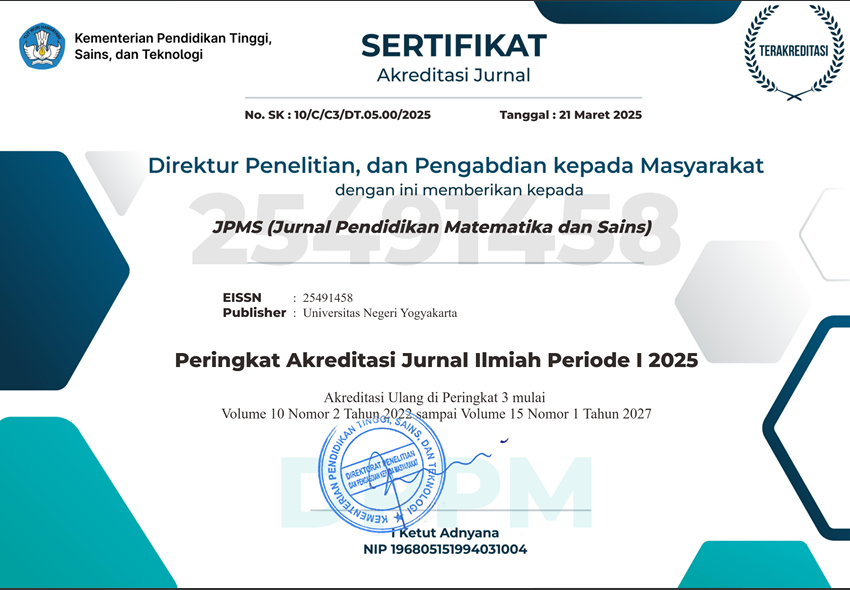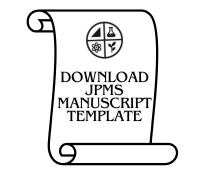Fostering Confidence in Chemistry: How Problem-Based Learning Elevates Self-Efficacy
DOI:
https://doi.org/10.21831/jpms.v13i1.84437Keywords:
Keywords, chemistry learning, self-efficacy, problem based learning, chemical equilibriumAbstract
This article examines the role of Problem-Based Learning (PBL) in fostering self-efficacy among high school students, emphasizing how this pedagogical approach enhances students' self-efficacy in their ability to understand and apply chemistry concepts. By engaging students with real-world problems, PBL promotes active participation and critical thinking, encouraging students to take ownership of their learning. The study investigates how PBL aids students in overcoming challenges traditionally associated with chemistry education by providing hands-on, direct experiences. The research shows a notable difference in students' self-efficacy before and after the implementation of PBL, while no significant change was observed in students' self-efficacy before and after using the scientific approach. This article offers valuable insights for educators seeking to implement PBL in chemistry classrooms as a strategy to enhance student outcomes, foster a deeper understanding of chemistry, and cultivate sustained interest in the subject.
References
Afifah, S., Mudzakir, A., Nandiyanto, A. B. D. (2023). How to Calculate Paired Sample t-Test using SPSS Software: From Step-by-Step Processing for Users to the Practical Examples in the Analysis of the Effect of Application Anti-Fire Bamboo Teaching Materials on Student Learning Outcomes. Indonesian Journal of Teaching in Science, 2(1), 81-92. https://doi.org/10.17509/ijotis.v2i1.45895
Amir-ud-Din R., Mahmood H. Z., Abbas F., Salman V., Zafar S. (2021). Leaving studies because of lack of interest: An analysis of the risk factors of school dropouts in Pakistan. Quality & Quantity, 56, 1–26. https://doi.org/10.1007/s11135-021-01266-9
Arlianty, W. N., Febriana, B. W., & Diniaty, A. (2017). An analysis of learning process based on scientific approach in physical chemsitry experiment. AIP Conference Proceedings. doi:10.1063/1.4978157
Arsyad, Muhammad & Guna, Saut & Barus, Sebastian. (2024). Enhancing Chemistry Education through Problem-Based Learning: Analyzing Student Engagement, Motivation, and Critical Thinking. International Journal of Curriculum Development Teaching and Learning Innovation. 2. 110-117.
Asghar S., Ajmal M. A. (2022). Adolescents' career decision making: A qualitative study. Pakistan Journal of Humanities and Social Sciences, 10(3), 952–967. https://doi.org/10.52131/pjhss.2022.1003.0259
Axboe, M.K., Christensen, K.S., Kofoed, PE. Ammentorp, J. (2016). Development and validation of a self-efficacy questionnaire (SE-12) measuring the clinical communication skills of health care professionals. BMC Med Educ, 16, 272. https://doi.org/10.1186/s12909-016-0798-7
Bandura, A. (1982). Self-efficacy mechanism in human agency. American Psychologist, 37(2), 122-147. doi: http://10.1037/0003-066X.37.2.122.
Bandura, A. (1994). Self-efficacy. London: Wiley Online Library.
Beckman, W. S. (2008). Pre-Testing as a Method of Conveying Learning Objectives. Journal of Aviation/Aerospace Education & Research, 17(2). Retrieved from http://commons.erau.edu/jaaer/vol17/iss2/5
Cardellini, Liberato. (2012). Chemistry: Why the Subject is Difficult?. Educación Química. 23. 305-310. 10.1016/S0187-893X(17)30158-1.
Costa, A. M., Escaja, N., Fité, C., González, M., Madurga, S., & Fuguet, E. (2023). Problem-Based Learning in Graduate and Undergraduate Chemistry Courses: Face-to-Face and Online Experiences. Journal of Chemical Education, 100 (2), 597-606. 10.1021/acs.jchemed.2c00741
Eggen, P. D., & Kauchak, D. P. (2012). Strategies and models for teacher sixth Edition. Boston: Pearson.
Ellizar, E., Hardeli, H., Beltris, S., & Suharni, R. (2018). Development of Scientific Approach Based on Discovery Learning Module. IOP Conf. Ser.: Mater. Sci. Eng. IOP Conf. Ser.: Mater. Sci. Eng. 335 (2018) 012101. 10.1088/1757-899X/335/1/012101
Firman, Baedhowi & Murtini, W. (2018). The Effectiveness of The Scientific Approach to Improve Student Learning Outcomes. International Journal of Active Learning, 3(2), 86- 91.
Gastwirth, Joseph & Gel, Yulia & Miao, Weiwen. (2010). The Impact of Levene's Test of Equality of Variances on Statistical Theory and Practice. Statistical Science. 24. 10.1214/09-STS301.
Goulí£o, M. d. F. The Relationship between Self-Efficacy and Academic Achievement in Adults"˜ Learners. (2018). Athens Journal of Education, 1(3), 237-246. Doi: https://doi.org/10.30958/aje.1-3-4.
Hmelo-Silver, C. E. (2004). Problem-based learning: What and how do students learn? Educational Psychology Review, 16(3), 235–266.
Hasija, Y. (2023). All About Bioinformatics From Beginner to Expert. Academic Press. https://doi.org/10.1016/C2022-0-01349-0
Hikmawati, H., Rokhmat, J., & Sutrio,S, (2017). The Implementation of Learning Devices with Scientific Approach to Improve Student Life Skills. Jurnal Pendidikan Fisika Indonesia. 13(1), 1-8. 10.15294/jpfi.v13i1.10152.
Hinduja, P., Fakir Mohammad, R., & Siddiqui, S. (2024). Factors Influencing Students' Academic Self-Efficacy in Related Domains. SAGE Open, 14(4). https://doi.org/10.1177/21582440241289738 (Original work published 2024)
Honicke, T., & Broadbent, J. (2016). The infuence of academic self-efcacy on academic performance: A systematic review. Educational Research Review, 17, 63–84. https://doi.org/10.1016/j.edurev.2015.11.002
Honicke, T., Broadbent, J., & Fuller-Tyszkiewicz, M. (2023). The self-efficacy and academic performance reciprocal relationship: the influence of task difficulty and baseline achievement on learner trajectory. Higher Education Research & Development, 42(8), 1936–1953. https://doi.org/10.1080/07294360.2023.2197194
Hu, X., Jiang, Y. & Bi, H. (2022). Measuring science self-efficacy with a focus on the perceived competence dimension: using mixed methods to develop an instrument and explore changes through cross-sectional and longitudinal analyses in high school. IJ STEM Ed, 9, 47. https://doi.org/10.1186/s40594-02200363-x
Hasanah, S. A., & Muchlis, M. (2024). The Effect of Assessment for Learning in Chemistry Learning on Students' Learning Outcomes. Jurnal Penelitian Pendidikan IPA, 10(8), 5992–6000. https://doi.org/10.29303/jppipa.v10i8.7611
Iqbal S., Aslam R., Niazi S. (2021). Critical analysis of the academic |performance of students at high secondary level (HSL). Pakistan Social Sciences Review, 5(4), 547–557. https://doi.org/10.35484/pssr.2021(5-IV)42
Kausar, F. N., Ghazala, N., & Haroon, A. (2022). Causes Of Students' Learning Difficulties In Secondary School Chemistry: A Study In Context Of Content And Assessment Strategies. Journal of Positive School Psychology, 6(10), 4443-4463
Khan M. A., Asif M., Khan A. S., Azeem M. (2020). Factors affecting the academic performance of students at higher secondary school level in Malakand District. Pakistan Journal of Society, Education and Language (PJSL), 6(2), 197–207
Maulidia, F., Saminan., & Abidin, Z. (2020). The implementation of problem based learning (PBL) model to improve creativity and self- efficacy of field dependent and field independent students. Malikussaleh Journal of Mathematics Learning (MJML), 3(1, 13-17. https://doi.org/10.29103/mjml.v3i1.2402
Matakaa, L. M., & Kowalske, M. G. (2015). The influence of PBL on students"˜ self-efficacy beliefs in chemistry. Chemistry Education Research and Practice, 16(4), 929-938. doi:http://10.1039/c5rp00099h.
Nemakhavhani, Rotondwa. (2024). Enhancing Student Engagement Through Problem-Based Learning: A Case of the Built Environment. International Conference on Education Research. 1. 238-245. 10.34190/icer.1.1.3053.
Okoye, K., & Hosseini, S. (2024). Understanding Dependent and Independent Variables in Research Experiments and Hypothesis Testing. In: R Programming. Springer, Singapore. https://doi.org/10.1007/978-981-97-3385-9_5
Ormrod, J. E. (2009). Educational psychology. New Jersey, NJ: Pearson Merrill Prentice Hall.
Raman, Yasheni & Surif, Johari & Ibrahim, Nor. (2024). The Effect of Problem Based Learning Approach in Enhancing Problem Solving Skills in Chemistry Education: A Systematic Review. International Journal of Interactive Mobile Technologies (iJIM). 18. 91-111. 10.3991/ijim.v18i05.47929.
Ramdhani, M. R., Usodo, B., & Subanti, S. (2017). Discovery Learning with Scientific Approach on Geometry. Journal of Physics: Conference Series 895, 012033. doi:10.1088/1742-6596/895/1/012033.
Ramnarain, U., & Ramaila, S. (2018). The relationship between chemistry selfefficacy of South African first year university students and their academic 90 performance. Chemistry Education Research and Practice, 19(1), 60-67. doi:10.1039/c7rp00110j.
Ross, A., Willson, V.L. (2017). Paired Samples T-Test. In: Basic and Advanced Statistical Tests. SensePublishers, Rotterdam. https://doi.org/10.1007/978-94-6351-086-8_4
Sofiyanita1., & Sari, E. K. (2024). The Effect of The Problem-Based Learning (PBL) Model on Student Self-Efficacy in Basic Chemical Laws. Intenational Conference on Emerging Trends on Science Education, 1, 176-184.
Schunk, D.H. (2012). Teori-teori pembelajaran: perspektif pendidikan (Ed 6). Yogyakarta: Pustaka Pelajar.
Siddiqui S., Soomro N. N., Thomas M. (2020b). Blended learning source of satisfaction of psychological needs: An empirical study conducted on O-levels chemistry students in metropolis city of Pakistan. Asian Association of Open Universities Journal, 15(1), 49–57. https://doi.org/10.1108/AAOUJ-11-2019-0054
Treagust, David & Duit, Reinders & Nieswandt, Martina. (2000). Sources of students difficulties in learning Chemistry. Educación Química. 11. 228-235. 10.22201/fq.18708404e.2000.2.66458.
Uzuntiryaki, E., & Aydın, Y. C.(2007). Development and psychometric evaluation of the high school chemistry self-efficacy scale. Sage Publication. 69(5). 868–880. doi: org/10.1177/0013164409332213
Vocational Instructional Materials Lab. (1998). Applied Mathematics: Targets for Learning Strategies for Preparing Successful Problem Solvers in the Workplace (pp. 36-40). Columbus: Ohio State University.
Witoko, R. & Wardono. (2019). Analisis Model Pembelajaran Open-Ended Learning (OEL) dengan Assessment for Learning (AfL) ditinjau dari Kreativitas Belajar Matematika. PRISMA: Prosidinng Seminar Nasional Matematika, 2, 748–753. Retrieved from https://journal.unnes.ac.id/sju/prisma/article/vi ew/29262
Zahoor I., Mahmood M. (2023). Career maturity level of intermediate students: A comparative analysis. Pakistan Journal of Educational Research, 6(1), 717. https://doi.org/10.52337/pjer.v6i1.717
Downloads
Published
How to Cite
Issue
Section
Citation Check
License
Copyright (c) 2025 Jurnal Pendidikan Matematika dan Sains

This work is licensed under a Creative Commons Attribution-ShareAlike 4.0 International License.
Jurnal Pendidikan Matematika dan Sains allows readers to read, download, copy, distribute, print, search, or link to its articles' full texts and allows readers to use them for any other lawful purpose. The journal allows the author(s) to hold the copyright without restrictions. Finally, the journal allows the author(s) to retain publishing rights without restrictions
- Authors are allowed to archive their submitted article in an open access repository
- Authors are allowed to archive the final published article in an open access repository with an acknowledgment of its initial publication in this journal

This work is licensed under a Creative Commons Attribution-ShareAlike 4.0 Generic License.





